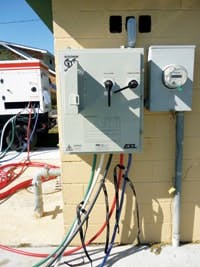When disaster strikes, we are quickly reminded of how critical emergency preparedness is to the public utilities industry and to the welfare of the general public.
Disasters remind us how dependent we are on the underlying infrastructure that delivers the clean water and waste removal we take for granted. Therefore, it is through smart emergency preparedness planning that the utility industry works to mitigate the impact of disaster.
However, oft overlooked is the critical importance of protecting a utility’s electrical infrastructure. Emergency backup power generation should be at the heart of any good emergency plan. While we have no control over the occurrence of disasters, facilitating quick post-emergency recovery can be key to safeguarding a community’s quality of life.
In Practice
When Hurricane Katrina hit the New Orleans region, the city of Gretna, La., received a brutal reminder of just how critical it is to have a robust emergency backup power solution in place. As a result of the hurricane, the city’s water and wastewater treatment plants and network of 14 sewer lift stations completely lost electrical power, shutting down the entire system.
Mike Baudoin, director of public utilities for the city of Gretna, recalled how area flooding, wind damage and generator failures knocked out nearly all of the city’s water and sewer system for days.
“The wastewater plant went down and the master lift station generator failed, but we didn’t find out about these failures until the storm had passed,” he said.
Baudoin’s own home was totally destroyed.
“I know what it’s like to experience a true catastrophe,” he said. “People can’t come back to their homes unless we have city infrastructure up and running. In the hurricane’s aftermath, both our wastewater plant generator and the 250-kW generator for the master lift station were found to be undersized and aged, requiring upgraded solutions.”
Following Katrina, the city contracted with engineering firm Burk-Kleinpeter Inc. (BKI) to upgrade and modernize its pump stations. Using a $1.8-million Mitigation Funding Block Grant from the state of Louisiana and the Federal Emergency Management Agency, BKI was charged with designing a cost-effective emergency backup electrical power solution that could quickly and easily be connected and operated by the four-person public utilities department without relying on electricians.
According to Bart Mullis, associate electrical engineer for BKI, the project deliverables encompassed significant improvements and upgrades to the electrical infrastructure for the wastewater treatment plant. An important part of the project included greater reliance on portable backup generators, as well as replacing one failed permanent generator and installing a second generator for redundant power at the two primary lift station facilities. A critical design choice was the addition of a manual power transfer switch to 11 sewer lift station pump sites and to the raw water intake location in order to facilitate easy connection to backup power.
“For wastewater facilities, backup generators serve the purpose of maintaining a safe flow of wastewater not associated with flood control,” Mullis said. “Because of the city of Gretna’s limited resources and small staff, we decided our client should rely on quick-connect portable power generators. That’s why we specified the StormSwitch manual power transfer switch system from ESL Power Systems. That choice eliminated the significant cost of permanently installed generators.”
The off-the-shelf system was selected for its quick-connect design, ease of operation and low cost. Now that the pre-wired system has been installed by a certified electrician, non-electrician employees easily can manage fool-proof operation.
According to Mullis, the manual power transfer switch system eliminated the added costs for a custom-engineered system. “The StormSwitch units allow city of Gretna workers to easily add emergency generator backup power to numerous pumping locations needing different amperages, while at the same time meeting the UL1008 standard with a robust NEMA-3R-rated enclosure and complying with NEC Article 702 requirements for optional standby systems,” he said.
Peace of Mind
Due to their critical nature, designated critical operations areas (DCOAs) at wastewater treatment facilities typically rely on emergency power generators as a backup in case of power loss from the grid.
Some facilities have automatic transfer switches and permanently installed generators instead of manual transfer switches and portable generators. Critical operations power systems (COPS) within these DCOAs are required to be tested regularly to ensure their reliability. COPS testing can be time consuming (i.e., load bank testing), but renders the facility susceptible to power outages while per- forming routine tests and maintenance.
Recently, a California water district’s maintenance manager installed 28 TripleSwitch electrical disconnect systems from ESL Power Systems to improve the method used to test emergency power backup for the facility’s COPS during annual load bank testing of the permanent generators.
The TripleSwitch shares the same technology platform as the manual power transfer switch system. With it utilities have found emergency preparedness checks, including load bank testing, to be quick, safe and less costly.
Unlike knife edge switches, the TripleSwitch system uses three interlocked circuit-breaker disconnects designed to isolate permanent and standby generator circuits from the grid.
Once installed, these new electrical technologies provide increased worker safety, peace of mind and considerable time savings by reducing risks associated with connecting and disconnecting generators from each other and the grid.
Despite how devastating long-term power outages can be, the initial and recurring costs for permanent backup power can prove prohibitive. This renders the use of portable backup power generators a cost-effective alternative solution for facilities interested in minimizing downtime during power outages.
“You can never have enough backup systems,” Baudoin concluded.
Fortunately, pre-engineered solutions installed at water and wastewater facilities offer affordable insurance against power outages.
Download: Here


